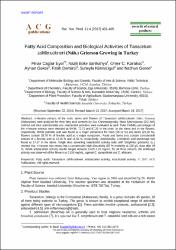Fatty Acid Composition and Biological Activities of Tanacetum zahlbruckneri (Nab.) Grierson Growing in Turkey

Göster/
Erişim
info:eu-repo/semantics/openAccessTarih
2017Yazar
Eyol, Pınar ÇağlarSarıkahya, Nazlı Boke
Karakoç, Ömer C.
Gökçe, Ayhan
Demirci, Fatih
Kirmizigül, Süheyla
Gören, Nezhun
Üst veri
Tüm öğe kaydını gösterÖzet
n-Hexane extracts of the roots, stems and flowers of Tanacetum zahlbruckneri (Nab.) Grierson (Asteraceae) were analysed for their fatty acid contents by Gas Chromatography-Mass Spectroscopy (GC-MS) method and their antimicrobial and insecticidal activities were evaluated as well. Total FAMEs percentages of the n-hexane extracts were detected as 69.94, 73.72 and 87.29 in the roots, in the stems and in the flowers, respectively. While palmitic acid was found as a major component for roots (26.12 %) and stems (21.28 %), flowers contain 33.78 % of linoleic acid as a major component. Roots and stems also contain considerable amount of a-linoleic acid as 15.30 % and 18.09 %, respectively. Additionally, a-linolenic acid percentage was found as 17.17 in the stems. Single dose screening insecticidal activity tests with Sitophilus granarius (L.) showed that n-hexane root extract has a considerably high bioactivity (83 % mortality at 100 g/L dose after 48 h). While antibacterial activity results ranged between 0.625-1.25 mg/mL for all three extracts, the antifungal activity was observed of the flowers as 0.156 mg/mL, against C. parapsilosis and C. albicans.

















